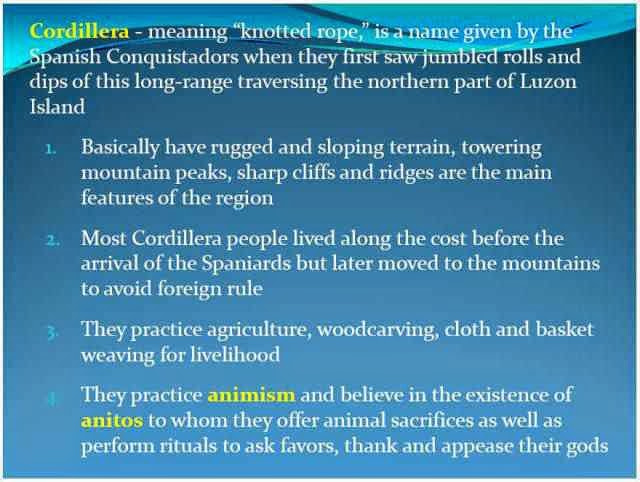Music of Cordillera
Based on the contents of the readings and links given above, fill in the boxes below with details regarding the Music of Cordillera
The music of the Highlands of Luzon (Cordillera) helps us discover the way of life of the Cordillera people through themes about nature, family life, work in the field as well as the spiritual matters. In addition to songs and chanted poetry, Cordillera music is distinctively made up of two sound characteristics of instruments based on their respective materials - the first, made of bamboo ((flutes, percussion instruments), and the second, made of metal (gongs). These traditions are on their way to extinction due to the modernization of the way of life among the youth of the Cordillera region. Less and less of the young generation are taught/learning the traditional music of their forefathers. Other threats to their music and most especially, their way of life are the conflict between state policies and their ancestral rights on land ownership, megatourism, militarization, and the shift from manual farming to machine-processed farming. Despite all these, several non-governmental organizations and international organizations like UNESCO ensure the protection not only of the rich culture and tradition of the Cordillera region but also of their people.
RESOURCES
Music of Cordillera
Vocal Music – Hudhud (chanted epic poetry)
Instrumental Music- Bamboo Stamping Tubes (Tongatong), Bamboo Pipes in a Row (Saggeypo), Bamboo Buzzers (Bungkaka), Bamboo Jew’s Harp
(Kubing), Patteteg (Bamboo Leg Xylophones), Gongs (Gangsa Topayya and Palook)
Cultural Context (History and Traditions) – Apayao, Bontok, Ibaloi, Ifugao, Kalinga, Tingguian
Composition: Chanted epic poetry, Dances
Social Functions: Music for Worship
Readings:
http://www.koleksyon.com/filipinoheritage/phil-music/pre-colonial-indigenous-music.asp
http://www.intangible.org/Features/kalinga/pages/page1.html (with audios and videos already)
http://www.unesco.org/culture/ich/index.php?RL=00015 (with audios and videos already)
Maceda, Jose (1998). Gongs and Bamboo. Quezon City: University of the Philippines Press.








